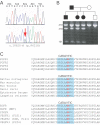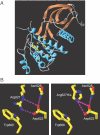A novel mutation in FGFR3 causes camptodactyly, tall stature, and hearing loss (CATSHL) syndrome
- PMID: 17033969
- PMCID: PMC1698566
- DOI: 10.1086/508433
A novel mutation in FGFR3 causes camptodactyly, tall stature, and hearing loss (CATSHL) syndrome
Abstract
Activating mutations of FGFR3, a negative regulator of bone growth, are well known to cause a variety of short-limbed bone dysplasias and craniosynostosis syndromes. We mapped the locus causing a novel disorder characterized by camptodactyly, tall stature, scoliosis, and hearing loss (CATSHL syndrome) to chromosome 4p. Because this syndrome recapitulated the phenotype of the Fgfr3 knockout mouse, we screened FGFR3 and subsequently identified a heterozygous missense mutation that is predicted to cause a p.R621H substitution in the tyrosine kinase domain and partial loss of FGFR3 function. These findings indicate that abnormal FGFR3 signaling can cause human anomalies by promoting as well as inhibiting endochondral bone growth.
Figures





References
Web Resources
-
- GenBank, http://www.ncbi.nlm.nih.gov/Genbank/ (for FGFR3 cDNA [accession number NM_000142])
-
- Online Mendelian Inheritance in Man (OMIM), http://www.ncbi.nlm.nih.gov/Omim/ (for ACH, HCH, thanatophoric dysplasia I and II, Muenke syndrome, Crouzon syndrome with acanthosis nigricans, LADD syndrome, WHS, and insulin receptor)
-
- RSCB Protein Data Bank, http://www.rcsb.org/pdb/Welcome.do (for human FGFR1 [entry 1FGK])
References
-
- Rohmann E, Brunner HG, Kayserili H, Uyguner O, Nurnberg G, Lew ED, Dobbie A, Eswarakumar VP, Üzümcü A, Ulubil-Emeroğlu M, Leroy JG, Li Y, Becker C, Lehnerdt K, Cremers CW, Yüksel-Apak M, Nurnberg P, Kubisch C, Schlessinger J, van Bokhoven H, Wollnik B (2006) Mutations in different components of FGF signaling in LADD syndrome. Nat Genet 38:414–41710.1038/ng1757 - DOI - PubMed
-
- Tavormina PL, Bellus GA, Webster MK, Bamshad MJ, Fraley AE, McIntosh I, Szabo J, Jiang W, Jabs EW, Wilcox WR, Wasmuth JJ, Donoghue DJ, Thompson LM, Francomano CA (1999) A novel skeletal dysplasia with developmental delay and acanthosis nigricans is caused by a Lys650Met mutation in the fibroblast growth factor receptor 3 gene. Am J Hum Genet 64:722–731 - PMC - PubMed
Publication types
MeSH terms
Substances
Associated data
- Actions
- Actions
- Actions
- Actions
- Actions
- Actions
- Actions
- Actions
Grants and funding
LinkOut - more resources
Full Text Sources
Other Literature Sources
Medical
Molecular Biology Databases

